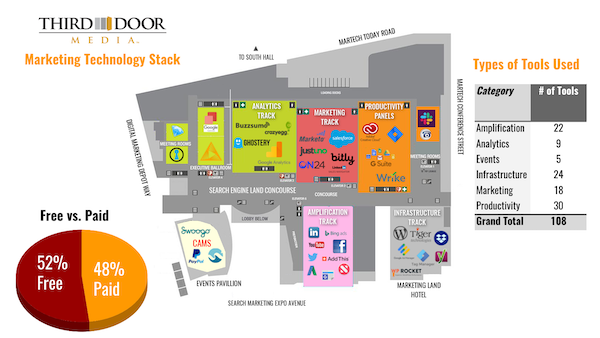For the past couple of years, I’ve been nudging the producers of the MarTech Conference, the amazing team at Third Door Media, to share their own marketing tech stack in The Stackies: Marketing Tech Stack Awards.
Of course, they wouldn’t be eligible to win. Marc Sirkin, their SVP of marketing and experience, is also one of the judges of the contest. But it would be in the spirit of experience sharing that is one of the hallmarks of the MarTech community. What does the marketing technology stack for a modern, 40-person, industry media company look like?
And, hey, since they’re producing the MarTech Conference, isn’t it even more interesting to see what their own stack looks like? That’s pretty meta, right?
I think the pressure of those expectations was one of the reasons they hesitated. As Marc said, “What would our sponsors think? Would we get inundated with sales calls from the rest of the marketing landscape? Would we look like amateurs?”
But they’d been so impressed by all of the other contributors to The Stackies over the years — and, like all of us in the community, have benefited from the educational value of all those real-world stack examples — that they decided to jump in and openly share theirs too.
In fact, Marc wrote a terrific article to accompany their stack that also describes the process they used to document and design it — along with some important lessons they learned along the way. Read Inside look: Third Door Media’s marketing technology stack.
Marc’s write-up includes a number of great insights:
- When you really count carefully, you have a lot more martech than you thought.
- Small business martech stacks aren’t inherently different than large business ones.
- “Infrastructure” can be an explicitly important part of your martech stack.
- Martech stacks grow organically, so over time, they naturally get a bit cluttered.
- A stack mapping exercise helps you identify and remove tools no longer being used.
- A stack visualization can help teams connect the dots across your organization.
- “A marketing technology stack is a living, breathing organism, not a static wall-chart or dry audit or assessment.”
They’ve got a 108 martech-related tools in their stack. That’s more than the average number of apps for a company their size, but given that they serve the digital marketing industry, it’s not surprising. The audience they engage with has a lot of digital touchpoints.
I’m also fascinated by the fact that more than half the tools they use are free.
Although they only show a subset of their tools with logos on their illustration, they do calculate the totals in six groups of capabilities:
- Amplification — tools to help get content to readers, subscribers, customers, etc.
- Analytics — tools that measure stuff
- Events — tools that help run events like SMX and MarTech, as well as webinars
- Infrastructure — web hosting, content management, and underlying technologies
- Marketing — marketing automation, URL shorteners, email optimization tools, etc.
- Productivity — anything related to project management, QA, contracts, etc.
Of course, the visual illustration of the stack is the least important element — what really matters is what’s in your stack and how you organize and manage it effectively inside your organization.
But a clever visual metaphor can be fun. They decided to lay theirs out as a conference map, superimposed on the floorplan for the San Jose Convention Center — which, to bring us fully into the meta martech zone, will be where the next MarTech Conference will be held in just a month, April 3-5. (Come join us and get to talk to Marc about their stack in person.)
Bravo, Marc, and the team at Third Door Media. As with all contributors to The Stackies, I’m incredibly grateful that you were willing to share your stack with the MarTech community.
And now, dear reader, if you’re so inspired, you still have an opportunity to share your stack in The Stackies. Entries are being accepted until midnight PST on Friday, March 15.
There’s no fee to submit an entry. In fact, for every entry, we’ll donate $100 to Girls Who Code, up to a total of $10,000. It’s a wonderful way to contribute to the MarTech community, as these different examples really do help us all learn what real marketing stacks are like.



